How to Charge for Veterinary Video Consultations
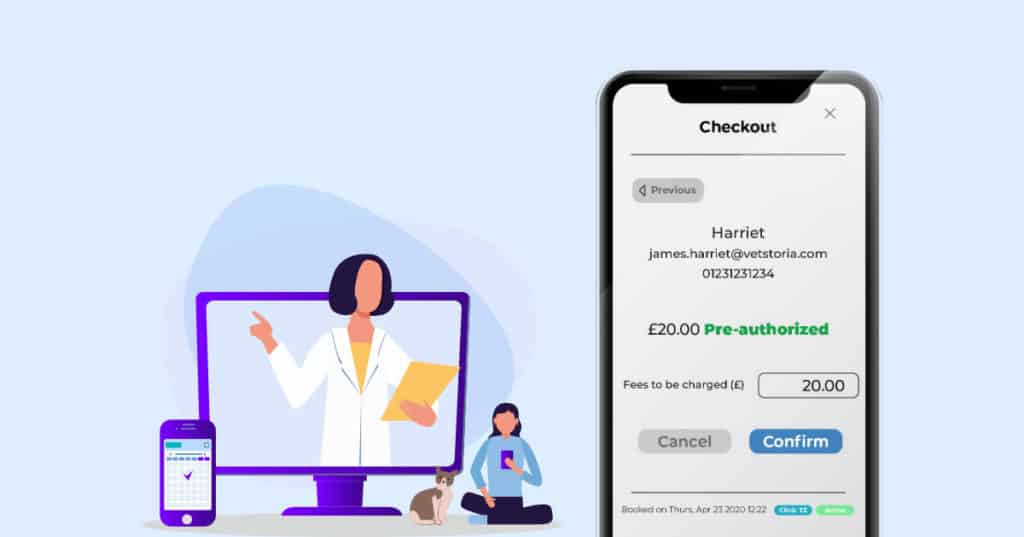
The COVID-19 crisis, with the social distancing measures and lockdowns put in place to combat it, have changed the way that many vet practices are operating. Some have closed their doors, whilst others have adapted by offering new services such as video consultations.
However, there’s one question that we keep hearing – “How should we charge for telemedicine video consultations?“
Do you maintain the same pricing that you use for in-person consultations? Do you take payment before or after the appointment? Do you take payment over the phone or online? All of these are valid questions that we aim to help you answer below.
How much to charge
Deciding how much to charge pet owners for video consultations can be difficult.
In theory, there shouldn’t be much of a price disconnect between in-person consultations and remote video consultations, especially if they take the same time to perform. However, the two types of consultations differ when it comes to results and follow-ups.
Although logistically video consultations may seem like an easier bet, it’s not just the 10 minutes of a vet’s time that is costly. There’s admin time and the cost of technology to be considered.
Generally, there are two schools of thought, and the approach you adopt depends on your practice’s needs.
Lower the price for video consultations from the standard charge for in-house consults.
This will also ensure easy access to pet care in the form of tele-triage outside the COVID-19 crisis.
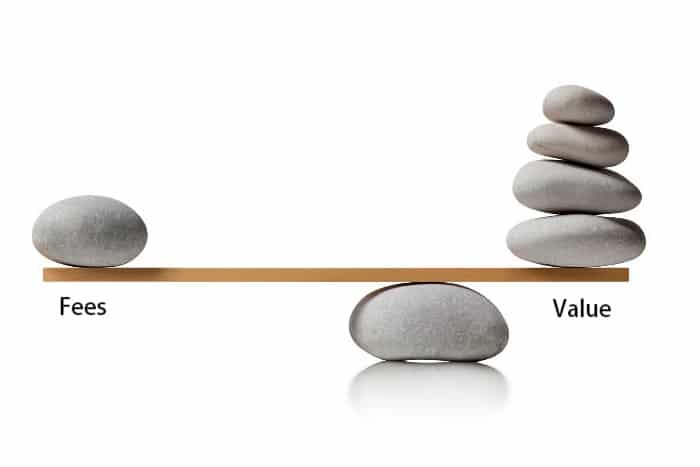
People who believe in this approach cite the lack of a physical examination as the main reason for why this should be charged less. The clinical examination cannot be replaced by looking at the animal through a video camera and the examination is a big part of the diagnosis.
The benefits such as detecting potential problems and prescribing preventive measures can only come from an actual physical examination, such as listening to the dog’s heart which leads to a diagnosis of heart disease.
The value they place on the additional triage is less than the value of a physical exam, which is why it should be charged less.
The second cluster of opinions suggests that a video consultation should be charged the same as a regular consultation.
The main reasons for this are:
- It takes a similar amount of time for the vet to do it on video as it does a face-to-face consultation
- There shouldn’t be a price disconnect that potentially creates discontent for pet owners
For many pet owners (and the pets themselves 😊), nothing beats seeing their regular vet who knows their pet and with whom there’s already a trusting relationship. It is not just the 15 min of ‘time’ they pay for but the 10+ years of experience and education that Dr. Google can never replicate.
If the pet-owner does get asked to go in, in the current climate this will mean that the importance of the pet being seen in person is so great that a trip is absolutely necessary. In this case, the value for the video consultation exceeds way beyond the face value because a serious condition has been discovered and planned for.
There are many ways to make either pricing models work for you. There is one last question you must ask yourself, so a better-informed decision can be made.
Have you surveyed your competition?
This is a testing time for all practices as well as the wider world. The veterinary industry is deemed an essential service unlike restaurants, music venues, and many others, which means we are relatively lucky. However, this hits some practices harder than others, especially those that don’t have the technology to facilitate telemedicine or remote working.
Are you in a position of monopoly so it’s less risky to price your video consultations higher? If so, it might be worth taking the risk in an effort to recover some of the business losses and maintain the revenue stream the best you can.
Try to invest time in carrying out competitive research. Check out your competitors’ websites and social media channels, what services are they offering pet owners and how much are they charging for them? Take this into account!
Has your team mastered working remotely? Check our full list of tools that help practices work better remotely.
When and how to take payments?
Due to the remote nature of video consultations, how and when to take payments is a concern of some veterinary practices.
When to take payment:
After the video consultation
Taking payment after a completed consultation has its pros and cons.
On the plus side, pet owners feel more comfortable committing to a service that they know will be delivered before parting with their hard-earned cash. Additionally, it allows for more flexibility in the service delivered. For example, if the consultation ends up being more extensive than first imagined, the price can be adjusted and paid after.
However, with post-consultation payments, there is a risk of pet owners not paying and a build-up of debt that needs to be chased, negatively impacting revenue and creating more admin workload. Busy receptionists may not have the time to make these payment request calls.
Just before the video consultation
Taking payment just before a video consultation is about to start is a viable option for practices that want to avoid the risks of non-payment and chasing bad debt. Furthermore, it takes away the stress of having to ask for payment at the end of the consult, which can create mixed feelings depending on the experience.
However, there are a couple of negatives associated with taking a payment just before a consultation. Firstly, it requires an admin effort to identify and contact those who are about to have consultations to get payment. Secondly, some pet owners may not be too keen on paying for a service that they are yet to receive.
During the booking process
This option is similar to the last in that payment is taken before a consultation takes place, however, it differs in that payment is taken as part of the booking process, whether that is online through a booking tool or over the phone by a receptionist at the time of booking.
The main benefit here is again the avoidance of potential non-payment for delivered consultations and chasing debt, as well as removing any ambiguity around what constitutes a consultation worth paying for from a pet owner’s perspective.
Additionally, if payment is taken during the booking process, it reduces the chance of “no-shows” and ensures an accurate schedule for the practice.
Finally, if payment is taken online in an automated fashion (e.g. pet owner visits your website to view availability, chooses a time and date, makes a payment to secure the booking, then shows up) no admin effort is required whatsoever.
Again, similar to the last point, some pet owners may not be keen on paying anything before receiving the service.
How to take payment
The method of taking payment is arguably just as important as when you take payments when it comes to admin effort and client satisfaction. The three most common methods of payment processing are phone payments, email invoices, and online payments.
Phone payments
The most common method that we’ve seen practices use to facilitate video consultation payments is over the phone.
The main benefit is that it offers a “personal touch” where a receptionist is able to explain the charge to a client and confirm receipt. Secondly, it’s reasonably fast and reliable.
However, there are two big issues with phone payments; firstly, they take up time that admin teams could otherwise spend doing other valuable tasks, and secondly, some pet owners are resistant to giving their card details out over the phone.
Email invoices
Another method that we’ve seen vet practices utilize is sending invoices for payment via email. Sometimes this process is automated and therefore faster than phone payments from an admin perspective. However, when the process is manual, it could take up valuable resources.
Either way, email invoices are a somewhat effective means of facilitation payment. However, unlike phone payments invoices lack a personal touch, and the delay between the invoice sent and paid can create cash flow problems.
Online payments
Taking payments online through a payment processor is the most efficient way of facilitating telemedicine video consultation payments. It is usually automated in nature, requiring less admin effort than the alternative methods and is perceived as a more secure option than sharing card details over the phone.
Furthermore, if integrated with the appointment booking process, it offers convenience to both the pet owner and practice, as payment can be taken upfront or pre-authorized to be taken after the consultation, so both parties avoid risk.
Like invoices, however, it can be argued that online payments have less “personal touch” than phone payments.
In conclusion
How much, when, and how to charge for video consultations is going to be different for every practice.
You need to consider your client-base and what their attitudes and expectations are (you could possibly survey them) and make decisions based on that. You also need to consider your internal processes to see what makes sense for your team.
If you usually take payments upfront then continue to do so – your clients will be expecting it.
If you’re short of staff or your reception team is overloaded, consider automating the taking off payments by shifting to online payments.
Whatever you decide, don’t be afraid to reassess once in a while and change things.
How Vetstoria Telemedicine can help
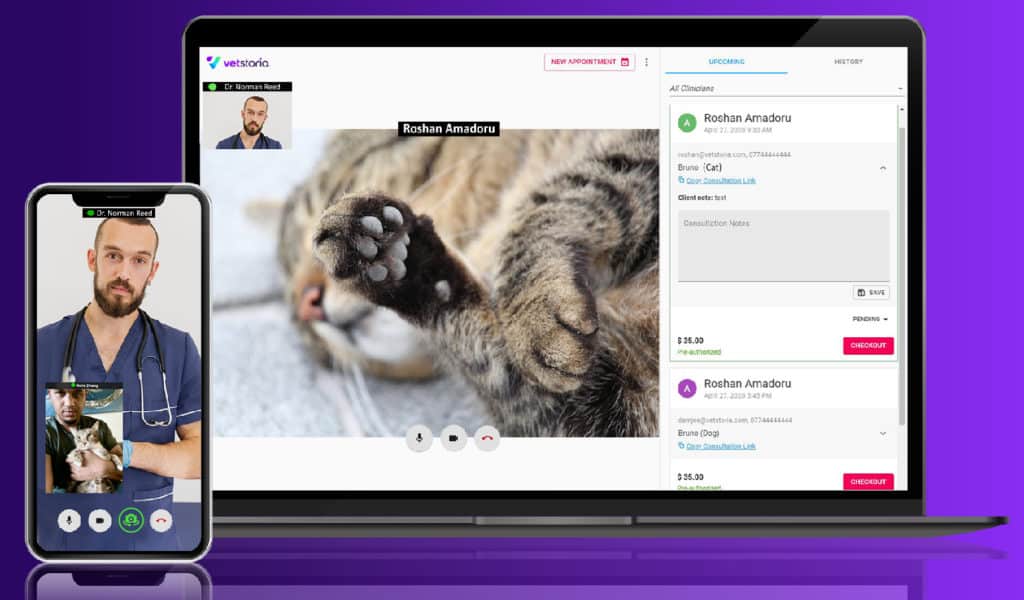
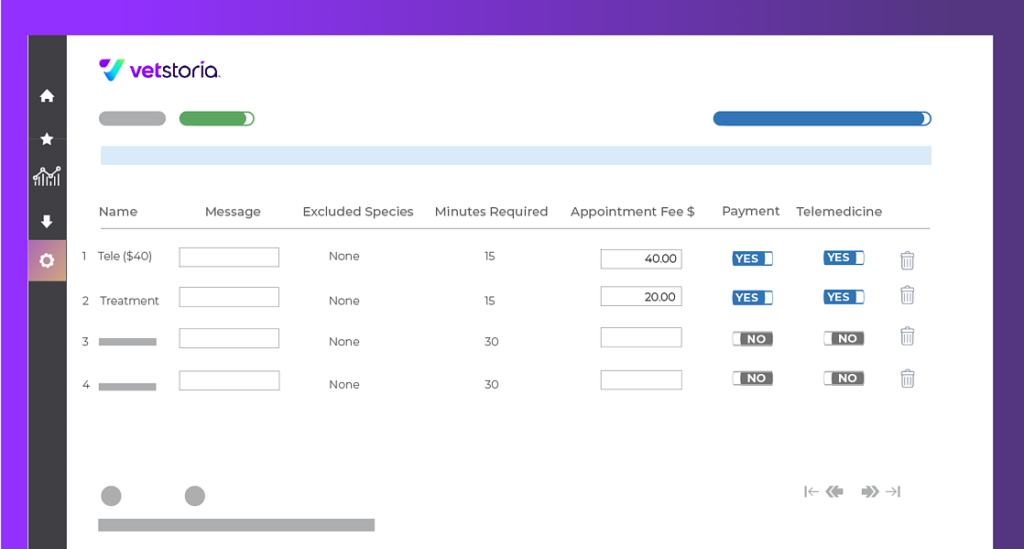
Vetstoria’s telemedicine tool not only integrates with your practice management system and handles telemedicine bookings in real-time online, but it also has an extra step in the booking process to collect the payment. This will give your practice peace of mind that the appointment will have been paid for, removing the need for the receptionist to keep an eye on the booking and collect payments which they may or may not obtain on the phone successfully.
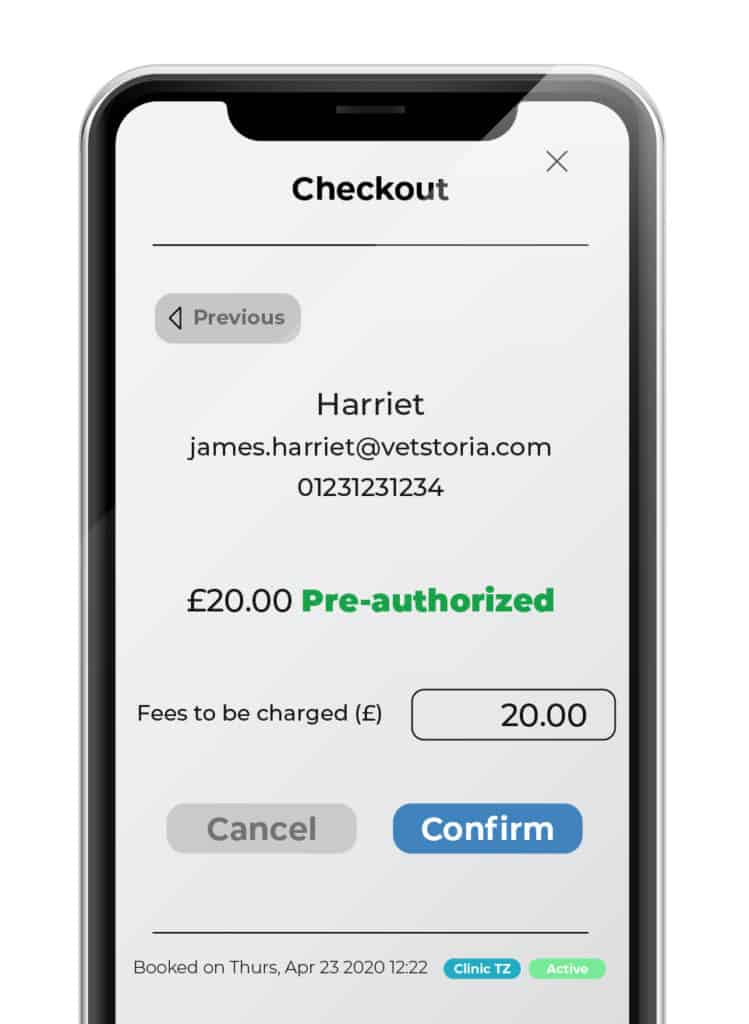
Once the payment has gone through, both the pet-owner and the practice will receive a confirmation email which includes the meeting link for the video consultation at the time of choosing. The interface works seamlessly across mobile, tablet, and computer browsers with absolutely no need for either party to download apps.
To learn more about Vetstoria’s telemedicine and payment capabilities book a demo, or if you’re an existing customer visit our knowledge base or contact customer support.
About the author
